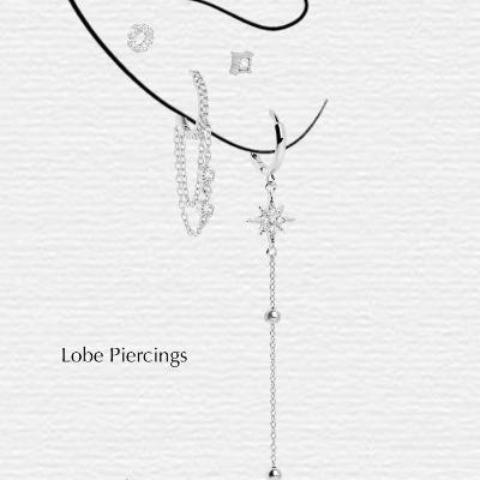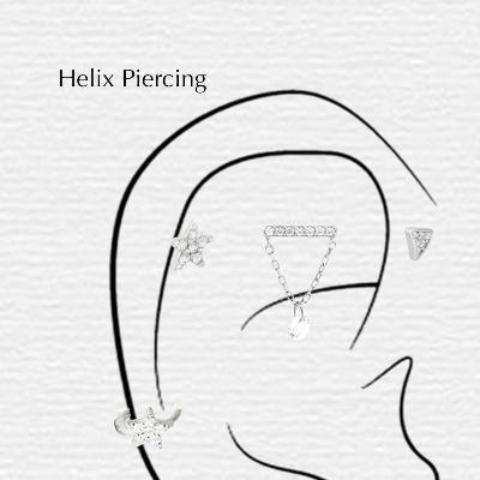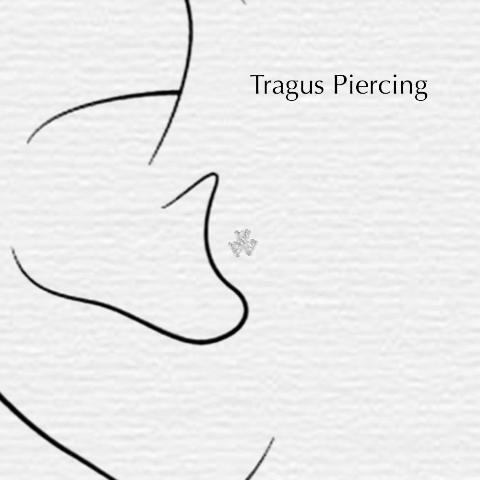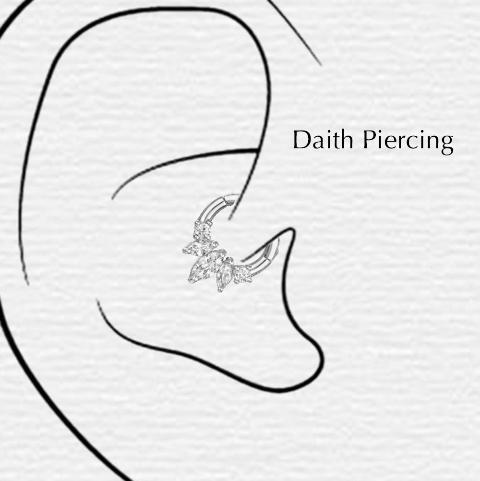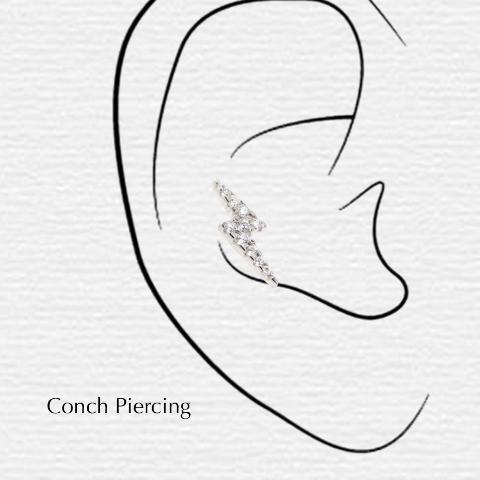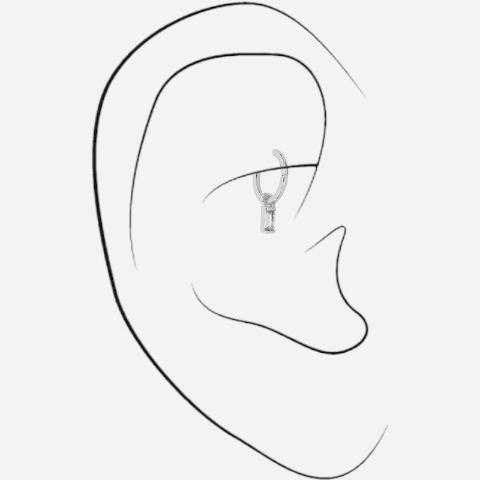Tragus Piercing: Healing Time and Care Guide
The tragus piercing is a trendy and fashionable choice for ear piercings. Located in the small flap of cartilage just in front of the ear canal, the tragus piercing adds a unique and stylish touch to your look. If you're considering getting a tragus piercing or have recently had one, it's essential to understand the healing process and how to properly care for it. Here's a guide to help you navigate the healing period and ensure a successful and comfortable piercing experience.
Healing Time:
The healing time for a tragus piercing can vary from person to person. On average, it takes about 6 to 12 months for a tragus piercing to fully heal. The tragus has a thicker cartilage composition, which means it may require a longer healing period compared to other ear piercings. It's important to be patient and follow proper aftercare practices to promote optimal healing.
Initial Aftercare:
After getting your tragus piercing, your piercer will provide specific aftercare instructions tailored to your needs. However, here are some general guidelines to keep in mind:
1. Cleanliness: Before touching your piercing or performing any aftercare, thoroughly wash your hands with soap and warm water to minimize the risk of introducing bacteria to the piercing site.
2. Cleaning Solution: Use a saline solution or a mixture of non-iodized sea salt and warm distilled water to clean your tragus piercing. You can either purchase a sterile saline solution from a reputable piercing or drugstore or make your own by dissolving 1/4 teaspoon of non-iodized sea salt in 8 ounces of warm distilled water. Soak a sterile cotton ball or a sterile saline spray with the solution and gently clean around the piercing, ensuring to reach both the front and back of the tragus.
3. Avoid Irritants: During the healing process, avoid exposing your tragus piercing to irritants such as hair products, perfumes, and cosmetics. These substances can introduce bacteria or chemicals that may hinder the healing process.
4. Be Gentle: Refrain from touching, twisting, or playing with the jewelry in your tragus piercing. Excessive movement can cause irritation, delay healing, or even lead to complications.
5. Clothing and Bedding: Choose clothing that won't snag or irritate your tragus piercing. Avoid clothing with high collars or tight headwear that may rub against the piercing. Opt for clean, soft bedding materials to minimize friction and discomfort while sleeping.
6. Avoid Swimming: It's best to avoid swimming in pools, hot tubs, and natural bodies of water until your tragus piercing is fully healed. These environments can harbor bacteria that may cause infections.
Ongoing Care:
Once your tragus piercing has fully healed, it's important to continue practicing good care to maintain its health and prevent any potential issues. Here are some tips for ongoing care:
1. Regular Cleaning: Clean your tragus piercing once a day with a saline solution or mild soap and water. Gently remove any crust or buildup around the jewelry and rinse thoroughly.
2. Jewelry Maintenance: Ensure that the jewelry in your tragus piercing remains clean and free from debris or buildup. Gently rotate the jewelry while cleaning to prevent it from sticking to the surrounding tissue.
3. Be Mindful of Headphones and Earphones: Avoid wearing tight or heavy headphones or earphones that may put pressure on or irritate your tragus piercing. If necessary, opt for over-ear headphones or earphones that don't directly touch the piercing.
4. Check for Signs of Infection: Regularly inspect your tragus piercing for signs of infection, such as excessive redness, swelling, persistent pain, or abnormal discharge. If you notice any of these symptoms, seek
medical attention promptly.
Remember, everyone's healing process is unique, and it's crucial to listen to your body. If you have any concerns or questions during the healing period or afterward, don't hesitate to reach out to your piercer or a medical professional for guidance and assistance.
The tragus piercing is a trendy and fashionable choice for ear piercings. Located in the small flap of cartilage just in front of the ear canal, the tragus piercing adds a unique and stylish touch to your look. If you're considering getting a tragus piercing or have recently had one, it's essential to understand the healing process and how to properly care for it. Here's a guide to help you navigate the healing period and ensure a successful and comfortable piercing experience.
Healing Time:
The healing time for a tragus piercing can vary from person to person. On average, it takes about 6 to 12 months for a tragus piercing to fully heal. The tragus has a thicker cartilage composition, which means it may require a longer healing period compared to other ear piercings. It's important to be patient and follow proper aftercare practices to promote optimal healing.
Initial Aftercare:
After getting your tragus piercing, your piercer will provide specific aftercare instructions tailored to your needs. However, here are some general guidelines to keep in mind:
1. Cleanliness: Before touching your piercing or performing any aftercare, thoroughly wash your hands with soap and warm water to minimize the risk of introducing bacteria to the piercing site.
2. Cleaning Solution: Use a saline solution or a mixture of non-iodized sea salt and warm distilled water to clean your tragus piercing. You can either purchase a sterile saline solution from a reputable piercing or drugstore or make your own by dissolving 1/4 teaspoon of non-iodized sea salt in 8 ounces of warm distilled water. Soak a sterile cotton ball or a sterile saline spray with the solution and gently clean around the piercing, ensuring to reach both the front and back of the tragus.
3. Avoid Irritants: During the healing process, avoid exposing your tragus piercing to irritants such as hair products, perfumes, and cosmetics. These substances can introduce bacteria or chemicals that may hinder the healing process.
4. Be Gentle: Refrain from touching, twisting, or playing with the jewelry in your tragus piercing. Excessive movement can cause irritation, delay healing, or even lead to complications.
5. Clothing and Bedding: Choose clothing that won't snag or irritate your tragus piercing. Avoid clothing with high collars or tight headwear that may rub against the piercing. Opt for clean, soft bedding materials to minimize friction and discomfort while sleeping.
6. Avoid Swimming: It's best to avoid swimming in pools, hot tubs, and natural bodies of water until your tragus piercing is fully healed. These environments can harbor bacteria that may cause infections.
Ongoing Care:
Once your tragus piercing has fully healed, it's important to continue practicing good care to maintain its health and prevent any potential issues. Here are some tips for ongoing care:
1. Regular Cleaning: Clean your tragus piercing once a day with a saline solution or mild soap and water. Gently remove any crust or buildup around the jewelry and rinse thoroughly.
2. Jewelry Maintenance: Ensure that the jewelry in your tragus piercing remains clean and free from debris or buildup. Gently rotate the jewelry while cleaning to prevent it from sticking to the surrounding tissue.
3. Be Mindful of Headphones and Earphones: Avoid wearing tight or heavy headphones or earphones that may put pressure on or irritate your tragus piercing. If necessary, opt for over-ear headphones or earphones that don't directly touch the piercing.
4. Check for Signs of Infection: Regularly inspect your tragus piercing for signs of infection, such as excessive redness, swelling, persistent pain, or abnormal discharge. If you notice any of these symptoms, seek
medical attention promptly.
Remember, everyone's healing process is unique, and it's crucial to listen to your body. If you have any concerns or questions during the healing period or afterward, don't hesitate to reach out to your piercer or a medical professional for guidance and assistance.

